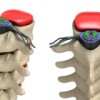The Discs of the Spine: An Overview
The bones of the spine are separated by tough cartilage pads called intervertebral discs (inter = “between”; vertebral = “bones of the spine”). Healthy discs are thick and flexible (like a wet sponge) allowing a wide range of bending and twisting motions. An unhealthy disc is stiff and hard (like a dry sponge) and prone to injuries such as bulging or herniation. Over time gravity, spinal joint dysfunction and accumulated trauma cause the discs to compress, flatten and degenerate. This constant compression prevents much-needed oxygen and nutrients from entering the disc. This ongoing starvation causes the once-tough outer layers of the disc to soften allowing the disc to become injured or diseased. Disc damage can occur anywhere in the spine. However, the discs of the neck (cervical spine) and low back (lumbar spine) are the most commonly injured.
A. |
B.
|
C. |
| Disc Bulge (A) | Herniated Disc (B) | Disk Rupture (C) |
Disease of the spinal discs can take many forms. Significant disc damage can lead to a Disc Bulge, become a tear called a Disc Herniation or the inner gelatinous material of the disc can leak out in the case of a Ruptured Disc. The “jelly center” of the disc can also dry out over time which is referred to as Degenerative Disc Disease. All forms of disc injury can eventually impinge on the nerves exiting the spine (“Pinched Nerve”) which can create numbness, tingling, burning or sharp pain down the arms or legs. Sharp pain originating from the back and “shooting” down the legs is often referred to as Sciatica.
Introduction to Degenerative Disc Disease
In order to understand the condition of Degenerative Disc Disease one must know two main facts about discs:
- Spinal discs do NOT have a direct blood supply. There are no arteries that feed the disc with oxygen and nutrients. Therefore, discs of the spine must receive their oxygen and nutrients from a different source. Normal, healthy discs are “fed” and oxygenated by the constant recycling of the disc fluid that occurs with spinal joint movement. This joint motion “sucks” in fluid filled with oxygen and nutrients and “pumps out” waste fluid. This process of fluid diffusion is greatly affected by internal disc pressure (intradiscal pressure) which brings us to key point #2:
- The discs of the spine are under constant pressure. The spinal discs are designed to absorb shock and maintain spinal flexibility by acting as cushions during body movement. The discs act similar to shock absorbers in a car. Car shock absorbers maintain a constant pressure to “push back” against the weight and movement of the car. Spinal discs act in a similar fashion. The pressure within the discs pushes the bones of the spine apart preventing them from crashing into one another during activities like running and jumping. Unfortunately, this constant internal disc pressure also pushes the fluid out of the disc consistently every day. This makes it difficult for the body to “suck” in new, healthy disc fluid with its much-needed oxygen and nutrients.
 These two factors make it difficult for the body to maintain thick, plump, healthy discs making Degenerative Disc Disease one of the more common spinal ailments.
These two factors make it difficult for the body to maintain thick, plump, healthy discs making Degenerative Disc Disease one of the more common spinal ailments.
| Degenerative Disc Disease: As the disc degenerates it loses height (Disc Height Reduction) allowing the bones above and below to “sandwich” the nerve between them. |
Degenerative Disc Disease, as the name implies, is caused by the progressive degeneration of the intervertebral disc. Nearly every physical activity (no matter how simple) places strain upon these discs. Over time, repeated daily stress and minor traumas begin to weaken the discs of the spine. This process of accumulated wear and tear will eventually lead to disc degeneration commonly referred to as Degenerative Disc Disease.
The process of disc degeneration often begins with a chronic lack of oxygen and nutrients. This can occur because of 1) greater than normal compression of the disc or 2) as a result of decreased hydration. Greater compression comes from repetitive harmful activities such as bending, lifting or twisting – even prolonged sitting can create abnormally high levels of disc compression. Decreased hydration occurs when less fluid is pulled into the disc than is “pressed” out of the disc. This slowly creates a deflated or dehydrated disc. The medical term for this lack of disc fluid is Disc Desiccation and is the MRI finding most commonly used to identify Degenerative Disc Disease.
Symptoms of Degenerative Disc Disease
The symptoms of Degenerative Disc Disease can vary widely depending on the location and severity of the condition. In general the degenerated disc itself causes little to no pain. If it does cause symptoms it often creates a stiffness around the affected joints or a deep ache that is often increased with movement of the joint. However, as the joint “warms up” the pain often decreases with this same body movement.
Although the degenerated disc often causes only mild symptoms, Degenerative Disc Disease can still cause severe pain and disability in other ways. The most serious problem related to Degenerative Disc Disease is direct nerve compression. This occurs when the spinal disc becomes thinner as part of the degenerative process. This thinning, also called Disc Height Reduction, causes the space between the bones to narrow. This narrowing also makes the hole between the nerves, the foramen, smaller, as well. Neural Foraminal Narrowing causes direct bone-on-nerve compression which can create such severe and debilitating symptoms as sharp pain, burning, numbness, tingling and muscle weakness. Over time this degenerative process can compromise the integrity of the nerve to the point that the organs controlled by these nerves can become diseased. Therefore, the most disconcerting problems associated Degenerative Disc Disease are not due to the disc itself, but how the disc degeneration causes the nerves to become injured as a result.
DTS Spinal Decompression Therapy
Prior to the recent advances in Spinal Decompression technology NO curative treatment was available for Degenerative Disc Disease. Treatments aimed at symptomatic relief only include physical therapy, anti-inflammatory medication, chiropractic care, home exercises, bed rest, narcotic pain medication, muscle relaxant medication, anti-depressant medication, epidural steroid injections and nerve blocks. The main surgical intervention has been to eliminate the disc entirely and fuse the bones above and below the disc together – cervical fusion or lumbar fusion surgery. Unfortunately, the success rate of this surgery is notoriously poor and repeat surgery rates approach 100% approximately 7 years following the initial surgery. Disc Replacement Surgery is still several years away from general use and initial results have been less-than-favorable.
Spinal Decompression is the ONLY treatment available that can reduce the symptoms of Degenerative Disc Disease by treating the CAUSE of the degeneration – chronic disc compression contributing to lose of disc fluid.
How Does it Work?
DTS Spinal Decompression reverses the ravages of Degenerative Disc Disease by slowly and methodically separating the bones of the spine thereby reducing pressure within the spinal discs. During treatment, pressure within the disc is reduced from approximately 25 millimeters of mercury (25 mmHg) to approximately 200 millimeters of mercury BELOW ZERO (-200 mmHg). This negative pressure forces water, oxygen and nutrients to diffuse INTO the disc thereby rehydrating the degenerated disc. Repeated spinal decompression treatments retract the gelatinous core (Nucleus Pulposus) back to the center of the disc. Recentering the nucleus pulposus relieves direct pressure on the nerve caused by the disc degeneration.
The Spinal Decompression treatment motion is computer controlled to provide gentle and painless decompression of the injured spinal discs. The DTS Spinal Decompression Therapy System incorporates an advanced treatment technique that slowly separates the bones of the spine while preventing protective muscle spasm from hindering the treatment. This decompression motion cycles between brief moments of separation and relaxation, known as oscillation, creating the pumping action necessary to re-hydrate the disc. The decompression is targeted to a specific disc level unlike outdated “traction” techniques that merely “pulled” the entire spine. This is accomplished by changed the Angle of Distraction. The natural curvature of the cervical spine and lumbar spine makes it possible to direct the decompressive distraction exactly perpendicular to the targeted disc by changing this Distraction Angle. This DTS innovation makes the treatment far more effective than other existing techniques AND more comfortable at the same time. In fact, the DTS Spinal Decompression treatment is so comfortable that patients often fall asleep during the treatment!


